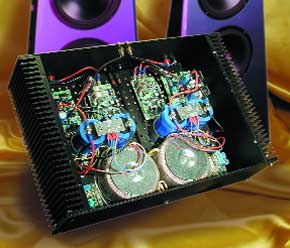Crescendo Millenium Edition
remake of a famous amplifier

This is a MEMBER ONLY article. You need a subscription to read this article.
- Unlimited access to online Member Only articles
- 3 new editions Elektor Magazine (digital)
- More than 5000 Gerber files
- 20% member discount on e-books (at elektor.com)
- 10% member discount on Products (at elektor.com)
Available from €5.33 per month.
What is Members Only
Elektor is committed to providing high-quality content on electronics, catering to tens of thousands of paying members. As part of this commitment, Elektor has launched Premium, an initiative that offers exclusive online articles to members sometimes even before they appear in the magazine.
Every day, members can access in-depth articles that showcase the best of Elektor's premium content.
This initiative aims to reward members with early access. Once logged in, members can easily enjoy this exclusive content and engage in discussions about featured projects. While Premium adds to the existing resources available, Elektor will continue to provide a wealth of free information.
Join the Elektor community today to take advantage of Premium and other benefits!
Materials
Gerber file
CAM/CAD data for the PCB referred to in this article is available as a Gerber file. Elektor GREEN and GOLD members can exclusively download these files for free as part of their membership. Gerber files allow a PCB to be produced on an appropriate device available locally, or through an online PCB manufacturing service.
Elektor recommends the Elektor PCB Service service from its business partner Eurocircuits or AISLER as the best services for its own prototypes and volume production.
The use of our Gerber files is provided under a modified Creative Commons license. Creative Commons offers authors, scientists, educators and other creatives the freedom to handle their copyright in a more free way without losing their ownership.
Component list
Resistors:
R1 = 1MOhm
R2 = 47kOhm
R3,R22 = 470Ohm
R4,R5 = 1MOhm 8
R6,R7,R11,R12 = 47Ohm
R8,R9,R13,R14 = 1kOhm
R10,R15 = 330Ohm
R16,R19,R30,R31 = 22kOhm
R17,R20,R28 = 270Ohm
R18,R21 = 8kOhm 2
R23 = 12kOhm
R24,R26 = 10kOhm
R25,R27 = 33Ohm
R29 = 120Ohm
R32,R33 = 220Ohm
R34,R35 = 0Ohm 22 / 5W low-inductance, e.g., MPC71 series
R36 = 10Ohm / 1W *
R37 = 1Ohm / 5W
P1 = 1kOhm preset H
Capacitors:
C1 = 2µF2, MKT (Siemens), lead pitch 5mm or 7.5mm
C2,C4,C5 = 1nF
C3 = 180nF
C6,C7 = 100µF 25V radial
C8,C9 = 220µF 25V radial
C10,C12,C14 = 100nF
C11 = 10nF *
C13,C15 = 1000µF 63V radial
Inductors:
L1 = 9 turns 1.5 mm dia. ECW around R37, inside diameter 8 mm
Semiconductors:
D1,D2 = rectangular face, red
D3,D4 = zener diode 3V9 / 0.5W
T1,T2,T6 = BC546B
T3,T4,T5 = BC556B
T7 = BC560C
T8 = MJE350
T9 = BC550C
T10 = MJE340
T11 = 2SK537 (Toshiba)
T12 = 2SK1530 (Toshiba)
T13 = 2SJ201 (Toshiba)
Miscellaneous:
5 off M3 spade terminals, PCB mount
3 off ceramic (or mica) isolating washer for voor T8/T10/T11
2 off mica isolating washer for T12/T13 (e.g., TO-218 sheets size 21 x 24 mm)
Heatsink: <0.5° K/W (e.g., Fischer type SK47/100 mm, Dau Components)
PCB, ord3r code 010001-1
Mainsd power-on delay PCB , order code 974078-1
Enclosre, e.g., Monacor (Monarch) type UC113/SW
*) may be omitted
Protection board
Resistors:
R1,R4 = 390Ohm
R2,R5 = 120Ohm
R3,R6 = 18kOhm
R7,R9 = 1kOhm / 5W
R8,R10 = 5kOhm 6
R11,R25,R30,R31 = 10kOhm
R12,R13,R24 = 1MOhm
R14 = 150kOhm
R15 = 39kOhm
R16,R20,R21 = 220kOhm
R17 = 330kOhm
R18 = 12kOhm
R19 = 330Ohm
R22 = 15kOhm
R23 = 680Ohm
R26,R27 = 4kOhm 7
R28 = 470kOhm
R29 = 3kOhm 3
Capacitors:
C1,C2 = 150pF
C3,C4 = 22µF 63V radial
C5 = 47µF 63V radial
C6 = 2µF2 MKT (Siemens), lead pitch 5mm or 7.5mm
C7,C8



Discussion (0 comments)
sercan 2 years ago
2sk537=IRFBF20
2SK1530=ECW20N20
2SJ201=ECW20P20
BC550C=BC850C
BC860C=BC860C
Brian Tristam Williams 2 years ago
Thanks!
Fabrício S Taveira 1 year ago
TonGiesberts 2 years ago
sercan 2 years ago
I am going to do your new project that 's been Fortissimo amp. But Really I am like to listen to mosfet sound. Do you have or know any project with mosfet amplifier on elector?
TonGiesberts 2 years ago
sercan 2 years ago
Laszlo Takacsy 1 year ago
TonGiesberts 1 year ago